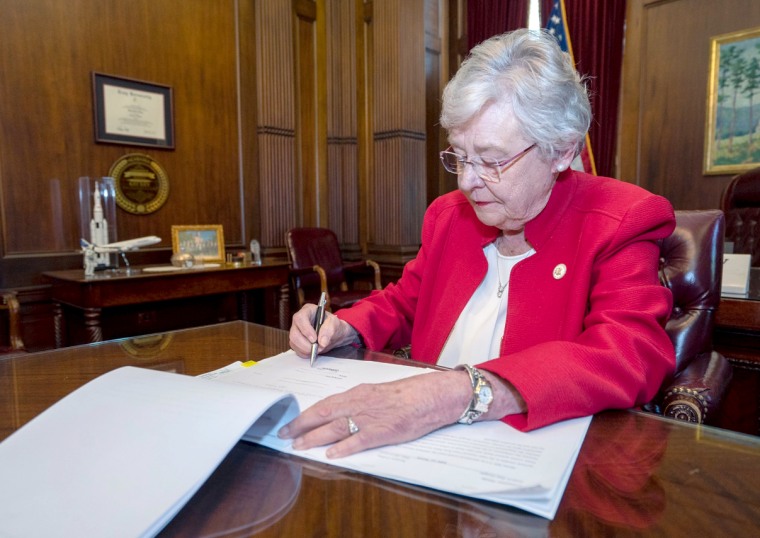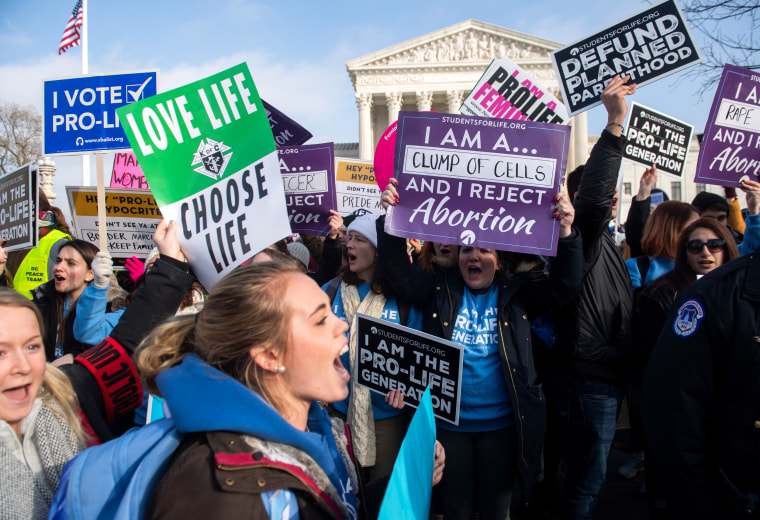The main storyline on reproductive rights for months now has been this: Men, many of them conservative, have moved to curtail access to legal abortion and even ban it, imposing their will upon women.
The truth, however, is more complicated.
White women have joined men, mostly but not exclusively in the Deep South, in using their conservative majorities in multiple state legislatures to make sweeping changes to abortion policies this year.
Those laws that survive legal challenges will most deeply affect women too poor to travel or move to a state with better access to abortion services. That’s a group that is disproportionately black and Latino — and, in the case of black women, a group that tends to support access to legal abortion. This gap between those making the decisions and those affected by them, experts say, is a dynamic with deep roots in American history.
The role of white women — long key players in dictating and constraining the reproductive choices of others — is too often discounted and overlooked, experts say. In 2019, new abortion restrictions were passed in Georgia, Alabama, Mississippi and Louisiana after white women co-sponsored them, many voted for them and in one state, signed the changes into law. (In those four state legislatures, 48 women — almost all of them white — voted for the restrictions.)
“These abortion laws, in combination with other policies, pretty much ensure that women who are already poor will remain poor with little chance to climb,” said Stephanie E. Jones-Rogers, a historian at the University of California, Berkeley, who wrote the book “They Were Her Property: White Women as Slave Owners in the American South.”
Among the reasons: Women who don’t have complete control of their fertility cannot make firm career or economic plans. And working parents must also find ways to cover the cost of child care, in which fees are typically assessed per child.
In Georgia, Alabama, Mississippi and Louisiana, the overall share of people living in poverty ranges from 12 percent to 17 percent. White poverty rates in those states are lower, between 7 percent and 10 percent, while black and Latino poverty rates are higher, ranging from 17 percent to 31 percent.
Exacerbating these disparities are weak social safety nets and worker protections in these four states, three of which have no state minimum wage and decided not to expand Medicaid under the Affordable Care Act. Last month, the Trump administration also announced plans to alter eligibility guidelines for federal food aid and school lunches, a decision that opponents say will put more financial pressure on families already struggling and receiving little in the way of government assistance.
Jones-Rogers describes the recent efforts to curtail abortion without expanding access to birth control or other social services as part of a lengthy history of policies and practices that have affected black women’s reproductive rights in America, dating back to slavery. These decisions, largely made by white men and women, had the effect of creating or maintaining a class of black workers who could not rise out of poverty — or, in the case of slavery, had no life choices at all.
The recent effort to change abortion policy “ties almost directly to a long history of needing and sometimes brutally creating a very cheap labor force in this county,” Jones-Rogers said.
During slavery, slave holders routinely sought female slaves of childbearing or near childbearing age and those with proven fertility and breastfeeding experience, Jones-Rogers said. Slave advertisements typically marketed men as strong, with mention of work skills and age. Women were often advertised with work histories and overt or subtle statements of the women’s childbearing histories and age, Jones-Rogers and other researchers have found.
As Jones-Rogers read testimonials of slaves gathered or published during and after slavery’s end as well as plantation owner journals, ads and other public records, something else became clear. Slave holders, including slave-owning women, sometimes coordinated the sexual assault of slave women by white men or other slaves. The goal: produce more slave children or potential wet nurses at times opportune for the owners. Slave children could be sold away and slave wet nurses hired out, producing more income for slave owners. And some slave women were punished for failing to become pregnant or trying to prevent a pregnancy with herbs or other means. All of this intensified when the nation outlawed importing slaves in 1808.
When the Civil War ended slavery almost six decades later, lawmakers in many states found ways of maintaining this unpaid workforce. Black Americans long barred from learning to read or write in many slave states were, in practice, all but confined to the lowest-paid work. Some states implemented policies making black people — including some children — subject to vagrancy laws if unemployed. The punishment involved compulsory, usually unpaid, labor.
At the same time, fears of free black Americans becoming a political force and a potential drain on social welfare resources led to black Americans being excluded from public benefit programs and shamed, discouraged or forcibly and surgically rendered unable to have children. By the early 20th century, white Americans on both the liberal and conservative ends of the political spectrum advocated reduced childbearing among the poor, organized early birth control experiments in Puerto Rico and Haiti, and pushed for targeted sterilization, Jones-Rogers said.
Eliminating abortion would have the opposite effect of these sterilization campaigns, but it’s yet another example of black women’s reproduction being targeted, influenced or controlled by policies in which they have limited input. Now, though, the discussion is framed around religion and values, rather than race and economics.
Abortion is a relatively new focus area for the mostly white evangelical conservatives behind the recent anti-abortion pushes at the state level.
Immediately after the Supreme Court decided Roe v. Wade in 1973, most white, Protestant conservatives did not consider the case consequential, Robert P. Jones, CEO of the Public Religion Research Institute, a research organization, said. Evangelicals from denominations such as the Southern Baptists and the Pentacostals viewed contraception and reproduction as Catholic preoccupations, he said.
All of this changed dramatically in the early 1980s. Upset after a Christian university lost its nonprofit status because of a ban on interracial dating, leading evangelicals such as Jerry Falwell joined forces with conservative Catholics. The alliance helped social conservatives achieve significant political influence, Jones said.
“It’s not until this point, when you get the ‘moral majority,’ that abortion becomes a stock evangelical talking point,” he said.
For much of the last decade, white women have been more likely to describe themselves as “pro-life” than black women have, according to a Gallup analysis of national polling data on abortion between 2010 and 2019, conducted at the request of NBC News. During that period, 46 percent of white women described themselves as “pro-life,” compared to 36 percent of black women.
Andrea Young, executive director of the American Civil Liberties Union of Georgia, has seen a pattern in the way abortion debates have unfolded.
“All over the South, ‘pro-life’ lawmakers have for years made little to no effort to increase aid to the poor,” Young, who is black and the daughter of a civil rights activist, said. “But, we have seen this relentless pursuit of an unconstitutional ban on abortion, an effort to force childbearing. And yes, you see both white Republican men and women deeply involved.”
There is no state where more than 25 percent of residents believe that abortion should be illegal in all cases, according to a poll conducted between March and December 2018 and released Tuesday by the Public Religion Research Institute. Researchers found that Louisiana came closest, with 23 percent of those surveyed saying that they supported a total ban on abortion. Just 16 percent of Alabama residents said the same. (The new state laws passed this year bar abortions after about six weeks of pregnancy in Louisiana and at any point in Alabama. Both laws include exceptions when the life of the mother would be placed at risk or the fetus unable to survive after birth.)
In Alabama, Rep. Terri Collins, the white Republican woman who introduced the abortion ban in the state’s House, described it as both a simple matter of lawmakers doing the people's will and a grand attempt to end abortion.
A white Republican woman, Gov. Kay Ivey, signed the bill into law.

White conservative women and men are not, of course, alone in opposing abortion. A full 42 percent of black evangelical Protestants and 37 percent of non-white Catholics told researchers with the Public Religion Research Institute that they believe abortion should be illegal in most or all cases.
This year in Louisiana, a handful of black Democrats voted for a bill banning abortion after about six weeks of pregnancy. (It will not be implemented unless a similar Mississippi law survives a challenge.)
Louisiana state Sen. Regina Ashford Barrow, a black woman and Democrat who voted for the Louisiana bill, also tried to build support for social programs in every room where the bill was discussed, she said. She serves as chair of the state Senate’s Health and Human Services Committee and worries that without increased social services, poor women will die from back-alley abortions. She introduced a bill that aims to identify pathways out of poverty and where existing aid program rules make escapes impossible. It passed.
“I believe in life from the womb to the tomb,” Ashford Barrow said, “and, to me, that means giving people the resources they need so they are able to raise every child in a dignified manner.”
But that kind of advocacy is not the norm among lawmakers who oppose abortion.
In Georgia, for example, the share of poor families receiving cash welfare aid slid from 82 percent in 1996 to 6 percent in 2017, according to federal data. Some employers in the state may legally pay workers $5.15 an hour.
So in June, shortly after Georgia lawmakers moved to restrict abortions beyond the sixth week of pregnancy, the ACLU of Georgia, Planned Parenthood of Georgia and black women’s organizations filed suit. The disproportionate effect the state’s new abortion policy could have on poor women of all races and women of color should not be ignored, the suit says.
Georgia is grappling with the worst maternal mortality rate in the country and it is mostly black women who are dying. The new state abortion policy violates the Supreme Court’s ruling in Roe v. Wade and restricts the options of the state’s poorest women without any improvement in the risks of giving birth in Georgia, the suit argues.
That law, set to go into effect Jan. 1, began with five sponsors in the Georgia House of Representatives. Three of the five Republicans are white women.




